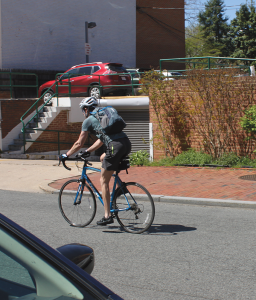
The D.C. Department of Education has proposed biking restrictions around the new streetcar lanes on H Street/Benning Road.
As testing continues for the D.C. Streetcar project, operation of the public transportation line is set to begin later this year, after a series of delays plagued the project.
Construction is complete on the H Street/Benning Road line connecting Union Station to Oklahoma Avenue in the northeast quadrant of the city. Testing began near the end of July as drivers learned how to maneuver traffic and control the unwieldy vehicles. Reggie Sanders, spokesperson for the District Department of Transportation, said that the project was on schedule to open later this year.
“We now have four cars moving up and down traversing the streetcar system between H Street and Benning. We are doing operator training, and we have 30 operators that have now completed their training,” Sanders said. “That’s very good news towards certifying the system, so we’re really happy with our progress.”
The streetcar runs on rails built into the streets, so operators can merely accelerate and decelerate — albeit slowly — along the track; they cannot change lanes in the street. Consequently, in addition to the 30 hours of required training, the testing process is of vital importance in familiarizing the operators with the road, and allowing drivers along the H Street/Benning Road corridor to learn safe practices while operating near streetcars.
Because the streetcar occupies one lane of the road, potentially increasing vehicular traffic in the area, the DDOT released proposed regulations limiting cycling on H Street in areas with rails. They will accept comments on the proposal until Sept. 27.
“We’re recommending that cyclists not be allowed to ride between the rails east and west on the streetcar because there’s simply not enough room,” Sanders said. “It’s not safe for cyclists to ride in front of the train and ride opposite or to the left or to the right of the train. There’s just not enough room. There’s too much vehicular traffic there to do that safely.”
To ensure cyclists still have a way to traverse the corridor, the DDOT installed “contraflow” lanes on G Street and I Street to the north and south of the streetcar line.
However, the Washington Area Bicyclist Association pointed out that H Street was a vital business corridor that cyclists could not reach anymore and urged the DDOT to make the street safer for bicycles to traverse.
“On H Street, the guideway is the entire street, effectively banning biking in this popular corridor. This is a problem,” WABA Communications Coordinator Colin Browne wrote in a post on the organization’s website.
The increased room required on the street for the vehicles has also caused a spike in parking tickets along the line, as previously available parking spaces have been eliminated to make room for the streetcar. The Department of Public Works reported giving out 143 tickets since July 24.
Sanders remained confident, however, that the community was still embracing the project.
“When you’re doing something this big, there’s always going to be concerns. We’ve reached out to many groups of people, and that includes businesses, to explain the effect it will have on them,” he said. “We work hard to keep everyone informed and to manage expectations and also to work with them on any problems that may have come about.”
The modern streetcar revives a dormant Washington, D.C. tradition for the first time in 50 years, though only after nearly a decade of deliberation. Although DDOT broke ground in 2004 on a line in the Anacostia district, the project faced contracting issues and delays that led to the project being shut down.
Despite the hiccups, the opening of the streetcar line in D.C. follows similar projects in cities like Atlanta and, according to Sanders, heralds more options for public transportation in the city.
“Streetcars are really short-trip ways of getting around town, and we’re moving towards a multi-modal transportation effort, where you can use bus or rail or car,” he said. “It’s of great value to the residents that live in those areas and the people who come to visit Washington.”
Current plans feature six stops along the way. Although the current line does not cross the Anacostia River, future development of the Streetcar system plans to include an extension across the waterway into Ward 7, as well as an extension in the other direction to Georgetown, which would make the system more accessible to students.
Sanders declined to comment on possible expansions.
John Reilly (COL ’17) said that he didn’t see the new streetcars having much of an effect on Georgetown students.
“It’s certainly an interesting idea. Right now, I can’t see the cars having a big impact on student life as they’re so far from the Hilltop. If a line is created connecting Georgetown and Union Station, it would be a great and easy way for students to cross the district,” Reilly said.














